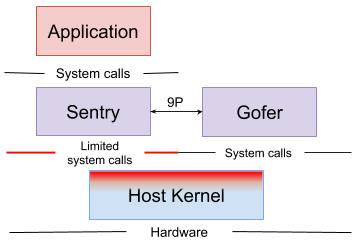3.8 KiB
Platform Guide
A gVisor sandbox consists of multiple processes when running. These processes collectively comprise a shared environment in which one or more containers can be run.
Each sandbox has its own isolated instance of:
- The Sentry, A user-space kernel that runs the container and intercepts and responds to system calls made by the application.
Each container running in the sandbox has its own isolated instance of:
- A Gofer which provides file system access to the container.
runsc
The entrypoint to running a sandboxed container is the runsc executable.
runsc implements the Open Container Initiative (OCI) runtime
specification. This means that OCI compatible filesystem bundles can be run by
runsc. Filesystem bundles are comprised of a config.json file containing
container configuration, and a root filesystem for the container. Please see the
OCI runtime spec for more information on filesystem bundles.
runsc implements multiple commands that perform various functions such as
starting, stopping, listing, and querying the status of containers.
Sentry
The Sentry is the largest component of gVisor. It can be thought of as a userspace OS kernel. The Sentry implements all the kernel functionality needed by the untrusted application. It implements all of the supported system calls, signal delivery, memory management and page faulting logic, the threading model, and more.
When the untrusted application makes a system call, the currently used platform redirects the call to the Sentry, which will do the necessary work to service it. It is important to note that the Sentry will not simply pass through system calls to the host kernel. As a userspace application, the Sentry will make some host system calls to support its operation, but it will not allow the application to directly control the system calls it makes.
The Sentry aims to present an equivalent environment to (upstream) Linux v4.4.
File system operations that extend beyond the sandbox (not internal /proc files, pipes, etc) are sent to the Gofer, described below.
Platforms
gVisor requires a platform to implement interception of syscalls, basic context switching, and memory mapping functionality.
ptrace
The ptrace platform uses PTRACE_SYSEMU to execute user code without allowing
it to execute host system calls. This platform can run anywhere that ptrace
works (even VMs without nested virtualization).
KVM (experimental)
The KVM platform allows the Sentry to act as both guest OS and VMM, switching back and forth between the two worlds seamlessly. The KVM platform can run on bare-metal or in a VM with nested virtualization enabled. While there is no virtualized hardware layer -- the sandbox retains a process model -- gVisor leverages virtualization extensions available on modern processors in order to improve isolation and performance of address space switches.
Gofer
The Gofer is a normal host Linux process. The Gofer is started with each sandbox and connected to the Sentry. The Sentry process is started in a restricted seccomp container without access to file system resources. The Gofer provides the Sentry access to file system resources via the 9P protocol and provides an additional level of isolation.
Application
The application (aka the untrusted application) is a normal Linux binary provided to gVisor in an OCI runtime bundle. gVisor aims to provide an environment equivalent to Linux v4.4, so applications should be able to run unmodified. However, gVisor does not presently implement every system call, /proc file, or /sys file so some incompatibilities may occur.
